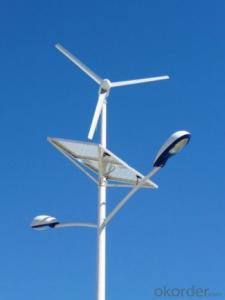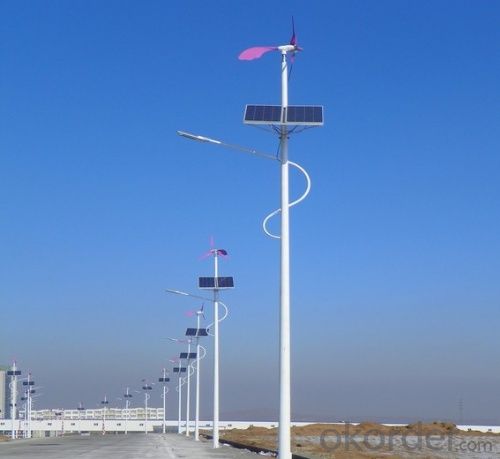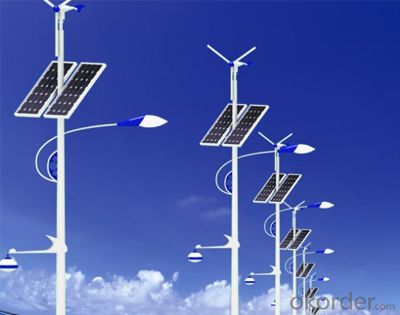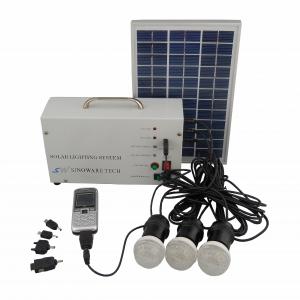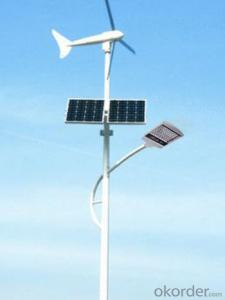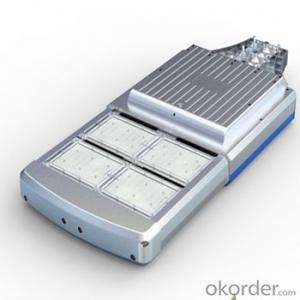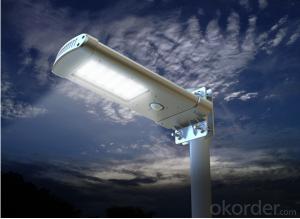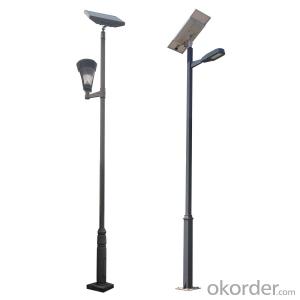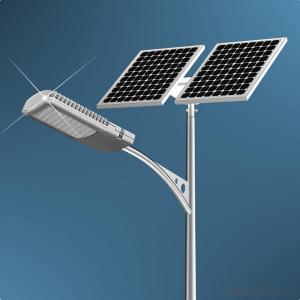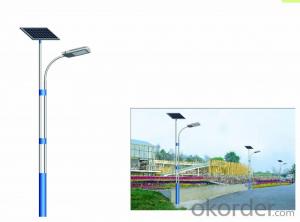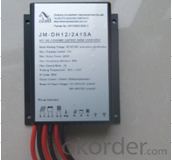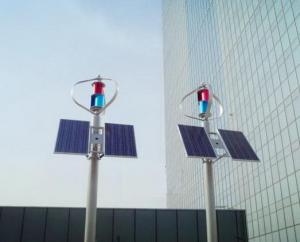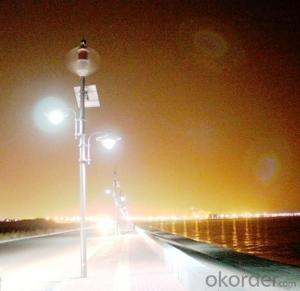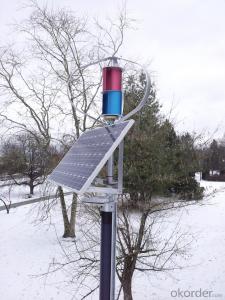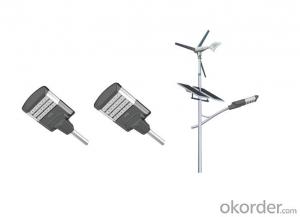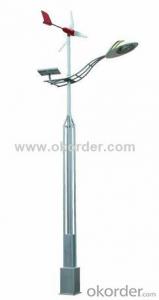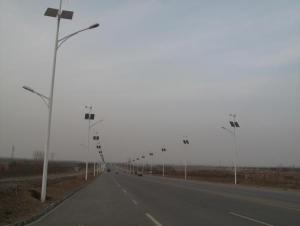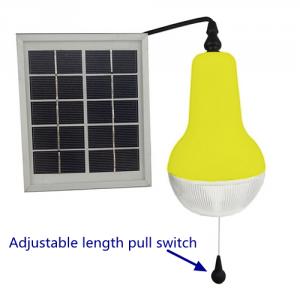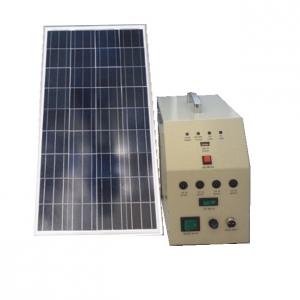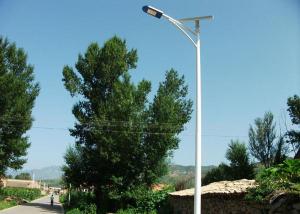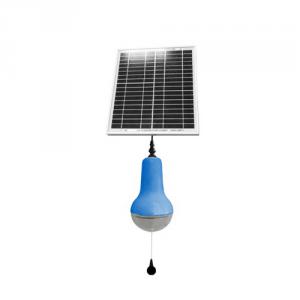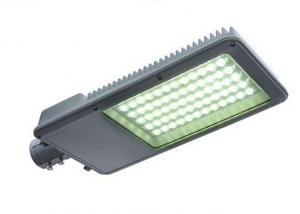Wind-Solar Hybrid LED Solar Light Street Lights
- Loading Port:
- Shanghai
- Payment Terms:
- TT OR LC
- Min Order Qty:
- 10 pc
- Supply Capability:
- 1000 pc/month
OKorder Service Pledge
Quality Product, Order Online Tracking, Timely Delivery
OKorder Financial Service
Credit Rating, Credit Services, Credit Purchasing
You Might Also Like
| 1. Discription: Wind-Solar Hybrid Street Lights | |||||
| 2. Characteristics: 20-80W 5-10M High 2000-7000 LM | |||||
| 3. Specification: | |||||
| Separate Parts: | |||||||||
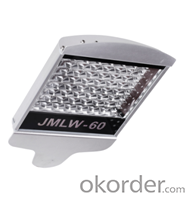 | 70w-80w led |
| PWM controller | 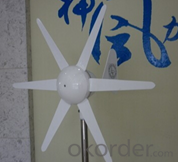 | 300w Hhigh-effective wind power generator (1.2 grade wind can start the wind generator ) | ||||
| American Bridgelux 3w/pc | 10%-100% 3 stages power energy-saving mode | ||||||||
| 110lm/w | |||||||||
| >80000 HRS | |||||||||
| Φ60mm | |||||||||
| IP65 | |||||||||
| Stretching Al | IP67 | ||||||||
| 5 years warranty | 3 years warranty | 3 years warranty | |||||||
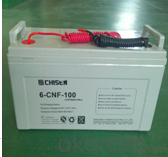 | Gel storage bat. | 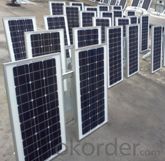 | mono-crystalline solar panel | 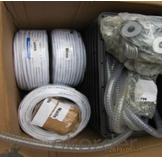 | engineerning plastic box, anti-corrosion, waterproof high quality nuts,crews, gaskets & cables | ||||
| 2000 times deep recycle in -30 ℃ ~55 ℃ scope can normal work. | |||||||||
| Conversion efficiency: 18% | |||||||||
| CE&TUV | |||||||||
| 3 years warranty | 5 years warranty | ||||||||
 | Pole with arm, built-in fit and PV bracket | ||||||||
| Q235 hot-dip galvanized | |||||||||
| 3.5-4.0mm thickness | |||||||||
| coating as client's requirement | |||||||||
| corrosion protection | |||||||||
| 5 years warranty | |||||||||
- Q: Are there solar lights for outdoor staircases or steps?
- Yes, there are solar lights available specifically designed for outdoor staircases or steps. These lights are typically compact, weatherproof, and have built-in solar panels to harness sunlight during the day and illuminate the stairs or steps at night. They are an energy-efficient and convenient option for enhancing safety and visibility in outdoor areas.
- Q: How do solar lights handle voltage drops over long cable distances?
- Solar lights typically have built-in voltage regulation mechanisms, such as charge controllers, to handle voltage drops over long cable distances. These charge controllers ensure that the solar panels receive a consistent and optimal voltage, regardless of the cable length or potential voltage drops. By regulating the voltage, solar lights can efficiently convert and store energy from the solar panels, allowing them to operate effectively even in remote locations with extended cable distances.
- Q: Are solar lights suitable for hiking or camping trails?
- Yes, solar lights are suitable for hiking or camping trails as they provide a reliable and eco-friendly source of light without the need for electricity or batteries. They are lightweight, easy to carry, and can be easily installed along the trail to enhance visibility and safety during nighttime activities.
- Q: How do I determine the appropriate number of solar lights for a specific area?
- To determine the appropriate number of solar lights for a specific area, you need to consider factors such as the size of the area, desired brightness level, and purpose of the lighting. Start by measuring the area to be illuminated and assessing the lighting requirements. Research the lumen output of the solar lights you are considering and calculate the total lumens needed for the space. Additionally, take into account the solar lights' coverage area and spacing recommendations provided by the manufacturer. By considering these factors, you can determine the appropriate number of solar lights needed to adequately light up the specific area.
- Q: How do I ensure proper placement of solar lights for optimal charging?
- To ensure proper placement of solar lights for optimal charging, there are a few key factors to consider: 1. Sunlight exposure: The most important aspect of solar light placement is ensuring they receive enough direct sunlight. Place the lights in an area that receives maximum sunlight throughout the day, preferably facing south in the Northern Hemisphere or north in the Southern Hemisphere. Avoid placing them under trees, buildings, or any other structures that can cast shadows and obstruct sunlight. 2. Angle and tilt: The angle and tilt of the solar lights can affect their charging efficiency. Adjust the angle of the solar panels to match the latitude of your location. In general, the optimal tilt angle is equal to the latitude minus 15 degrees in the winter and plus 15 degrees in the summer. This allows the solar panels to capture sunlight at the most effective angle for charging. 3. Clear panels and regular cleaning: Keep the solar panels clean and free from dust, dirt, or debris. Regularly wipe the panels with a soft cloth or sponge to ensure maximum light absorption. Dirty or obstructed panels can significantly reduce the charging efficiency of solar lights. 4. Avoid any obstructions: Make sure there are no obstructions blocking the path of sunlight to the solar panels. Trim any overhanging branches or vegetation that might shade the lights. Also, ensure that neighboring structures or objects do not cast shadows on the solar panels during the day. 5. Optimal distance between lights: If you have multiple solar lights, try to space them out adequately to avoid shading or competition for sunlight. This will ensure each light receives sufficient sunshine for optimal charging. 6. Seasonal adjustments: Keep in mind that the sun's angle changes throughout the year due to the Earth's tilt. Consider adjusting the tilt angle of the solar lights seasonally to compensate for this change and maximize their charging potential. By following these guidelines, you can ensure proper placement of solar lights for optimal charging, allowing you to enjoy bright and efficient lighting throughout the night.
- Q: Are there any safety precautions to consider when using solar lights?
- When using solar lights, there are several safety precautions to keep in mind. To begin with, it is crucial to ensure the secure installation and mounting of the lights, particularly in outdoor areas where they may be subjected to strong winds or extreme weather conditions. This will prevent any potential hazards or falls. Furthermore, it is of utmost importance to adhere to the manufacturer's instructions regarding the charging and handling of the solar lights. Overcharging the batteries can cause overheating and potentially lead to a fire. Hence, it is crucial to avoid leaving the lights connected to the solar panel for an extended period, especially during times of excessive sunlight. Another safety consideration is to keep the solar lights away from materials or substances that can easily catch fire. Although solar lights do not generate heat like traditional lights, it is always better to exercise caution and keep them far from any potentially flammable objects. Additionally, it is important to regularly inspect the solar lights for any signs of damage or deterioration. If any wires are frayed or exposed, immediate replacement or repair is necessary to prevent any electrical hazards. Lastly, it is highly recommended to turn off the solar lights when not in use, particularly if you are leaving the premises. This will conserve energy and reduce the risk of any electrical malfunctions or accidents.
- Q: Can solar lights be used in conjunction with traditional electric lights?
- Solar lights can be used alongside traditional electric lights, serving as an excellent alternative due to their dependence on solar energy and lack of reliance on external electrical sources. Typically utilized for outdoor purposes, such as garden, pathway, or security lighting, solar lights may not offer the same level of brightness or illumination as their electric counterparts. Consequently, combining solar lights with traditional electric lights can prove to be a practical solution, ensuring ample lighting in necessary areas. This combination proves particularly advantageous in regions with limited sunlight or during overcast days when solar lights may not receive adequate sunlight for full charging. By incorporating both solar and electric lights, you can establish a dependable and energy-efficient lighting system tailored to your requirements.
- Q: How do solar lights prevent over-discharging?
- Solar lights prevent over-discharging by incorporating a built-in mechanism called a charge controller. This device regulates the charging and discharging of the battery, ensuring that it does not go below a certain voltage threshold. When the battery is fully charged, the charge controller stops the charging process, preventing excessive charging and over-discharging. This helps to prolong the lifespan of the battery and ensures efficient operation of the solar light.
- Q: Can solar lights be used for lighting up outdoor sculptures or statues?
- Yes, solar lights can definitely be used for lighting up outdoor sculptures or statues. Solar lights are designed to harness the energy from the sun and convert it into electricity, which is then stored in batteries. These batteries power the lights during the night, eliminating the need for electrical wiring or outlets. Outdoor sculptures or statues often serve as focal points in gardens, parks, or public spaces and require effective lighting to enhance their beauty and visibility. Solar lights are an excellent choice for this purpose as they are easy to install, cost-effective, and environmentally friendly. When choosing solar lights for lighting up outdoor sculptures or statues, it is important to consider a few factors. Firstly, ensure that the solar lights have a sufficient capacity to provide adequate illumination. Look for lights with higher lumens and adjustable brightness settings to customize the lighting as per your preference. Additionally, consider the solar panel's placement to ensure it receives ample sunlight during the day. Ideally, position the solar panel in an area that receives direct sunlight for several hours to maximize energy absorption. Furthermore, consider the design and aesthetics of the solar lights to complement the sculpture or statue. There are various styles and finishes available, including spotlights, floodlights, or string lights, which can provide different lighting effects and enhance the ambiance of the outdoor space. In conclusion, solar lights are a great option for lighting up outdoor sculptures or statues. They offer convenience, cost savings, and environmental benefits while effectively illuminating and showcasing these art pieces in the outdoor environment.
- Q: Can solar lights be used as portable lighting?
- Yes, solar lights can indeed be used as portable lighting. Portable solar lights are designed to be lightweight and easy to carry, making them perfect for outdoor activities such as camping, hiking, or even backyard parties. These lights are equipped with small photovoltaic panels that convert sunlight into electricity, which is stored in built-in batteries. This stored energy can then be used to power the light during nighttime or in areas with limited access to electricity. Additionally, some portable solar lights come with additional features like USB ports, allowing you to charge your electronic devices on the go. Overall, solar lights offer a convenient and eco-friendly solution for portable lighting needs.
Send your message to us
Wind-Solar Hybrid LED Solar Light Street Lights
- Loading Port:
- Shanghai
- Payment Terms:
- TT OR LC
- Min Order Qty:
- 10 pc
- Supply Capability:
- 1000 pc/month
OKorder Service Pledge
Quality Product, Order Online Tracking, Timely Delivery
OKorder Financial Service
Credit Rating, Credit Services, Credit Purchasing
Similar products
Hot products
Hot Searches
Related keywords
